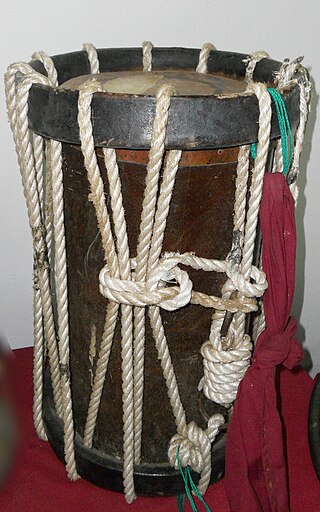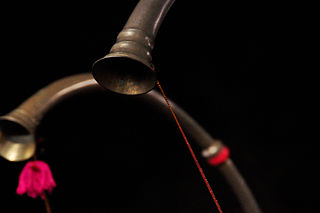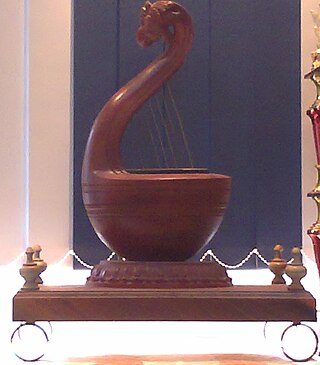
Music of Tamil Nadu has a long tradition and history going back thousands of years. Music is a very important aspect of marriage and temple festival Tamil people.

Dappankuthu is a folk dance and music genre with an emphasis on percussion performed in the South Indian state of Tamil Nadu. It is one of several popular genres employed in film music, mainly in Tamil cinema and other South films, filmed and produced by people of Tamil culture. It has been imported to Telugu culture and cinema under the Telugu name teenmaar.
Melam is a group of Maddalams and other similar percussion instruments' (Chenda) rhythmic performance. Those who play melam are called 'Melakaar'. In ancient Tamilakam melam was used for all the occasions in temples, marriages, functions, funeral wake(Parai Melam). In Kerala the most traditional of all melams is the Pandi Melam, which is generally performed outside the temple. Another melam called the Panchari Melam, which is similar to Pandi Melam, but the Panchari Melam is played inside the temple.

The Chenda is a cylindrical percussion instrument originating in the state of Kerala and widely used in Tulu Nadu of Karnataka and Tamil Nadu in India. In Tulu Nadu, it is known as chende. It is greatly identified as a cultural element in Kerala and Tulu Nadu.

The Kombu or Kompu also known as the Kombu Pattu is a wind instrument in Tamil nadu and Kerala. Usually played along with Panchavadyam, Pandi Melam, Panchari melam etc. This musical instrument is usually seen in south India. The instrument is like a long horn.
Gair dance is one of the popular, famous folk dances from Rajasthan in India which is mostly performed by the Bhil community but found in all over Rajasthan.

The ancient Tamil music is the historical predecessor of the Carnatic music during the Sangam period spanning from 500 BCE to 200 CE.

The urumi is a double-headed hourglass drum from the state of Tamil Nadu, South India. Two skin heads are attached to a single hollow, often intricately carved wooden shell. The preferred wood is jackwood, although other woods like rosewood may be used. Both left and right heads are usually made from cow hide that is stretched around a thin metal ring. The outer circumference of each head is perforated with approximately seven to eight holes. The two heads are held in tension by a continuous rope that is woven around the drum in a V-shape pattern. Additional small coils of string or metal are tied around each pair of ropes near the left head. These coils can be slide horizontally along the length of the drum, increasing or decreasing the tension between the heads as necessary. For example, during the monsoon season the drum heads will slacken so much that the instrument becomes unplayable. Using these coils drummers can easily rectify such problems.
Dance forms of Tamil Nadu elaborates the various dance forms originated and practiced in the Tamil Nadu, the southernmost state of the India. Tamil Nadu is the home of the Tamil people, who speak Tamil language, one of the oldest surviving languages with archaeological evidence pointing to the Tamilakam region being inhabited for more than 400 millennia and more than 5,500 years of continuous cultural history. Hence, culture have seen multiple influences over the years and have developed diversely. With its diverse culture, many forms of individual and group dances have their origins in the region and are practiced.
Kolattam is an ancient folk dance practiced mainly in Tamil Nadu and Kerala. It is usually performed by women using two short wooden sticks, one in each hand. The dancers generally stand in a circular formation and crisscross the sticks to make specific rhythms while singing folk songs. The dance is usually dedicated to Hindu gods or goddesses and performed during harvest season and village festivities.
Tamil culture is the culture of the Tamil people. The Tamil people speak the Tamil language, one of the oldest surviving languages. Archaeological evidence points to the Tamilakam region being inhabited for more than 400 millennia and has more than 5,500 years of continuous cultural history. Hence, the culture has seen multiple influences over the years and have developed diversely. With Tamils migrating world-wide, the culture has become diverse and forms a significant part of the life of the people in India and other regions with significant Tamil diaspora such as Sri Lanka, South East Asia and Carribbean.

The pambai or pamba is a pair of cylindrical drums used in temple festivals and folk music in Tamil Nadu and Andhra Pradesh, India.

Uruttu Chenda is a type of "Chenda" or drum used to play variations in Chenda music. It is used to lead the orchestra. It is called the ""Pramanavadhya"". The "Chenda Vattam" of the "Uruttu Chenda" is always the "Edam Thala" or the "Left Head" which is made of soft, single cow skin. The meaning of "uruttu" in Malayalam language is "rolling". The artist produce sound on "Uruttu Chenda" by rolling his right hand wrist. During the first beat the palm holding the stick will face the artist (in), then during the second beat the palm would face the opposite side (out). This is done by rolling the wrist.
Many sports are played by the people of Tamil Nadu including both traditional sports and sports from other countries.

Tharai Thappattai or Thaarai Thappattai is a 2016 Tamil-language musical art film written, produced and directed by Bala. The film features M. Sasikumar and Varalaxmi Sarathkumar in the leading roles, while Ilaiyaraaja composed the film's music based on karakattam. This film also happened to be Ilaiyaraaja's 1000th film. The film began production in 2013 and released on 14 January 2016. Ilaiyaraaja won the National Film Award for Best Background Score at the 63rd National Film Awards.

Poikkaal Kuthirai Aattam or Puravi Aattam is one of the folk dances of Tamil Nadu. It is a type of dance performed with a dummy horse having a gap inside so that a person can fit into it to perform the dance.
Sri Lankan Paraiyar is a Tamil caste found in northern and eastern Sri Lanka. They are traditional parai-drummers who were also involved in weaving and scavenging.

Tharai or Thaarai is a wind instrument from South India. It is a traditional instrument played during festivals, folk dances, weddings and functions. The instrument in played predominantly in Tamil Nadu and in some parts of Kerala. There are many variants of the instrument, including longer and shorter versions, curved or straight and the outer pipe may be made of metal or wood. The instrument might be played along with Thappattai, a percussion instrument in folk dances and festivities or accompanied by traditional Thavil and Nadaswaram in rituals and functions.












